The U.S. Department of Agriculture (USDA) and regulatory agencies have been turning their attention to how to promote and encourage sustainable agriculture. A key component to promoting regenerative agriculture has been the increase in the use of cover crops. In February 2021, the USDA published the study “Cover Crop Trends, Programs, and Practices in the United States” which took a look at the new incentives and impacts of cover crops.
The study found that on U.S. cropland, the use of cover crops increased by 50 percent between 2012 and 2017. This increase in part came from increased financial and technical assistance from Federal and State conservation programs. The report is built from a series of farm- and field-level surveys that asked American farmers how they were managing cover crops on corn, cotton, soybean, and wheat fields. The report revealed that the approach to using cover crops is varied and includes considerable variation in the other soil-health-related practices farmers use with cover cropping, such as no-till farming, conservation cropping, and soil testing.
When implemented correctly, cover crops have many farm benefits from reduced soil erosion, improved water infiltration, greater weed and pest suppression, and lower nutrient loss. Cover crops can also lead to greater soil carbon sequestration by trapping carbon in the soil. As more links between soil health and the environmental benefits of using cover crops increase, Federal and State government agencies are looking for more ways to help grow these environmentally beneficial initiatives.
Why Cover Crop Adoption is Growing in the US
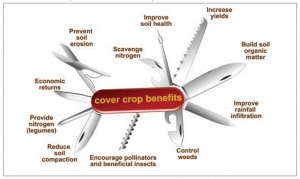
Figure 1: The many benefits that cover crops provide contribute to increasing yield response and lower input costs over time. Illustration by Carlyn Iverson. Source
In 2012, there were 10.3 million acres of cover crops planted in the United States according to the latest USDA data. That number increased by 50% to 15.4 million acres planted in 2017. However, less than 10% of acres in the U.S. are being cover cropped. There are only 230 million acres of corn, soy, cotton, wheat across the country. Farmers are rapidly expanding the planting of cover crops. Cover crops include grasses, legumes, and forbs, for seasonal cover and other conservation purposes. They are primarily used for erosion control, soil health improvement, and water quality improvement. As a conservation practice focused on reducing erosion and increasing organic matter, cover crops are often considered alongside tillage practices. There is still potential for cover crops to increase since both no-till and conservation tillage are much more widely adopted than cover crops. However, cover crops can involve increased costs, at least in the short term, because of additional field operations and seed purchases.
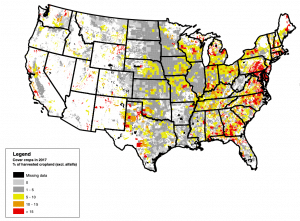
Figure 2: Cover crop adoption as a share of harvested acreage by county, 2017. USDA, Economic Research Service estimates using 2017 Agricultural Census, USDA, National Agricultural Statistics Service. Source
Government Financial and Technical Assistance for Cover Crops
In many Federal and State programs in 2018, cover crops range from $12 to $92 per acre, with the median cost being $37 per acre. That same year, about one-third of the cover crop acreage planted received financial assistance from either Federal, State, or other programs that support cover crop adoption. In the fiscal year 2018, the USDA’s Environmental Quality Incentives Program (EQIP) put $155 million in planned payments toward cover crops on about 2 million acres. This level of financial support for cover crops in comparison to the support in 2005 is about 20 times, through EQIP, primarily due to an increase in acres enrolled in cover crop practices. Lastly, in 2018, at least 22 states supported more than 1 million acres of cover crops.
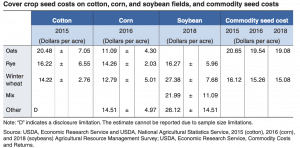
Figure 3: Cover crop seed costs on cotton, corn, and soybean fields, and commodity seed costs. Source
There are many benefits of cover crops, however, the benefits depend on the future cash crops. Legume cover crops increase the available nitrogen, therefore they are more beneficial to nitrogen feeding crops such as corn. However, legume cover crops often take longer to produce biomass in the spring. In contrast, grasses or small grains work well to scavenge leftover nitrogen from the preceding crop. Although, these cover crops are high residue and have a high carbon-to-nitrogen ratio which causes a reduction in the available nitrogen for the following cash crops. In addition to their potential nutrient benefits, cover crops also increase residue on the soil surface, which can reduce erosion between cash crop seasons, buffer soil temperature extremes, suppress weeds, and contribute organic matter for increased long term soil health. This residue can be especially beneficial following low-residue crops such as corn silage, cotton, and soybeans.
CIBO comes into the equation after farmers start implementing these environmental practices. CIBO delivers a new, higher standard of assurance on the impact of sustainable farming. Our verification process uses remote satellite sensing, computer vision, and physical inspection to confirm that a practice happened. The platform is able to verify tillage practices, cover cropping, cash crop emergence, and nitrogen application and many other practices. With this verification, CIBO is able to quantify, verify and register carbon credits.
How Cover Crops can become a Cash Crop
Now that Federal and State governments are offering financial and technical assistance for cover crops, growers can look for new ways to leverage this help to pay for the additional cover crop costs. According to the report, these programs provided more than $180 million in total incentives for the adoption of cover crops on more than 5 million acres of cropland in 2017. During the past 14 years, USDA funding for cover crops has increased—both in absolute terms and relative to other practices included in the programs such as no-till. Between 2005 and 2018, funding for cover crops through EQIP increased from about $7 million to more than $155 million (in 2018 dollars) see figure 4.
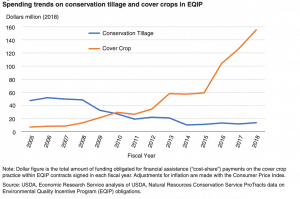
Figure 4: Spending trends on conservation tillage and cover crops in EQIP. Source
Some of the benefits of cover crops, particularly the accumulation of soil organic matter, require frequent or sustained adoption. The report found that the frequency of cover crops varied by the type of cash crop it was implemented over (see figure 5). “With the upward trend in adoption, these numbers are impacted by new adopters, so fields that are adopting cover crops in only 1 or 2 years out of the 4 years will be more common than they would be if cover crop adoption were stable.”
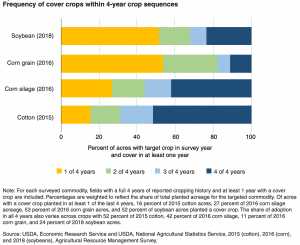
Figure 5: Frequency of cover crops within 4-year crop sequences. Source
While the startup costs of cover crops can be expensive, these programs help to incentivize new cover crops and deliver environmental benefits. Once growers have begun these practices, they should look into enrolling their fields into carbon credit programs.
Carbon credit programs promote regenerative agriculture while helping to reduce greenhouse emissions and increase soil health. By adopting conservative farming practices, fields will be able to lower the use of nitrogen, decrease input costs, increase yields and productivity, increase biodynamics in the root and soil ecosystem.
CIBO believes growers should be compensated for the proactive regenerative practices they are implementing. We’re inviting farm operators, owners, and managers alike to register now for our CIBO Impact™ program.
CIBO Impact is a breakthrough new approach to supporting, measuring, and, most importantly, compensating farmers for sustainable practices. CIBO requires no multi-year contract commitments, no expensive and distracting soil sampling, and no disruption to your current operations. Simply sign up and get paid.
Read the full report: https://www.ers.usda.gov/webdocs/publications/100551/eib-222.pdf?v=5803



